
The new data for March 2019 is in. This May 2019 HUD Code production data update is arguably more serious than any other bloggers or trade media in manufactured housing dare publish.
This Daily Business News on MHProNews report will reflect the latest toplines. But it will also shed light on how this 7 month trend arguably more serious than alternative theories promoted by numerous ‘association mush’ sycophants that are emanating from several corners of MHVille.
Let’s bullet some of the reasons why this new data further below is arguably worse than what many are saying.
- First and foremost, there is an affordable housing crisis. FEMA, inventory adjustments, and other excuses that Joe Stegmayer, Kevin Clayton or others who regurgitate their words without analysis have shared are arguably just that, excuses. Stegmayer contradicts himself on that very point, as the link above reflects, because encountering declining new manufactured home shipments during a growing affordable housing crisis is arguably a klaxon that should signal ‘all hands-on deck’ to get to the root issues.
- Thousands of manufactured homes that are going into manufactured home communities are rental units. As MHProNews exclusively reported, taken in aggregate, there are producers – both MHI, MHARR members or non-aligned producers of HUD Code manufactured homes – that have told the Daily Business News on MHProNews the following for years. If rentals going into manufactured home land-lease communities were factored out, the true level of new home sales has been largely flat or are declining in numbers of states.
- Given the arguably growing number of negative reports in the media that can be traced back to the influence of Warren Buffett dark-money recipient non-profits, such as Manufactured Housing Action (or MHAction) is an issue that MHProNews alone has raised publicly.
- Bad news stories coming out of Iowa, California, Colorado, New York or other states are routinely connected to MHI “big boy” community or other members.
Let’s be clear. There are retailers, communities, and producers who can sincerely report improving results in new home sales. But that doesn’t change the fact that the overall trends are down.
What follows are details from the Manufactured Housing Association for Regulatory Reform (MHARR), released earlier today. It should be noted that MHARR makes their reports, used as is with proper credits, available for others to publish. Which begs the question. Why does MHInsider, George F. Allen, MHR, or others fail to publish these kinds of reports?
More after their report, which follows.

FOR IMMEDIATE RELEASE Contact: MHARR
(202) 783-4087
HUD CODE PRODUCTION DECLINE CONTINUES
Washington, D.C., May 6, 2019 – The Manufactured Housing Association for Regulatory Reform (MHARR) reports that according to official statistics compiled on behalf of the U.S. Department of Housing and Urban Development (HUD), year-over-year HUD Code manufactured home production declined once again in March 2019. Just-released statistics indicate that HUD Code manufacturers produced 7,590 homes in March 2019, down 14% from the 8,830 homes produced in March 2018. Cumulative industry production for 2019 now totals 22,359 homes, a decline of 12.4% from the 25,531 HUD Code homes produced over the same period in 2018.
This ongoing significant production decline, following a long period of only modest industry growth after its modern-era production low in 2009, underscores the importance and validity of the decision by the MHARR Board of Directors to begin aggressively tackling (by mid-May) three major issues – zoning exclusion, placement discrimination, and the failure of the Government Sponsored Enterprises, to date, to provide market-significant securitization and secondary market support for manufactured home personal property loans. These three major issues, individually and in combination, have worked to inhibit and stifle the growth of the manufactured housing market after the industry’s outstanding homes leave the factory, and deny millions of Americans the affordable, non-subsidized homeownership that manufactured housing can uniquely provide.
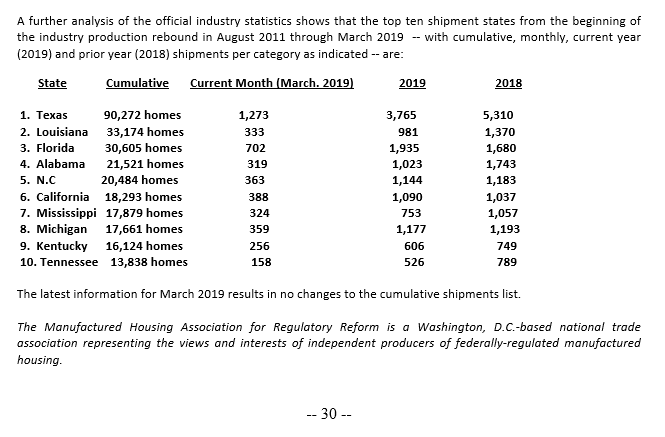
BTW, the video posted below is the source for the feature image above. It is a reminder of what several publicly traded companies investor reports reflect. Namely, that they are a source of about 1/3 of all new HUD Code manufactured home orders. In the case of many land-lease communities, those properties are often buying rental housing to fill vacant sites, instead of filling vacant sites with sold or spec-for-sale manufactured homes.
It will also be recalled that some weeks ago, the Wisconsin Housing Alliance (WHA) Executive Director Amy Bliss told MHR that she was worried about a possible downturn. But that was in the wake of MHI – who Bliss is arguably a routine surrogate for – was touting “momentum” in the MHI self-promotion video. Given that MHI could or should have advance data on these trends, one can argue that MHI deliberately misled their own members. To ‘soften’ what the powers-that-be knew was coming, did Bliss float her comments?
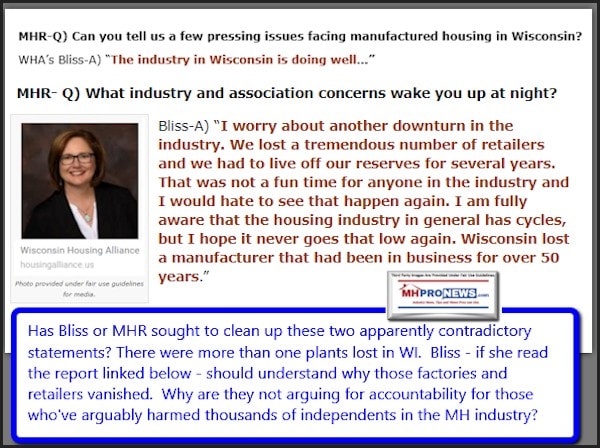
MHI’s outside attorney had the chutzpah to threaten MHProNews for reporting the following using their own graphics and stills.
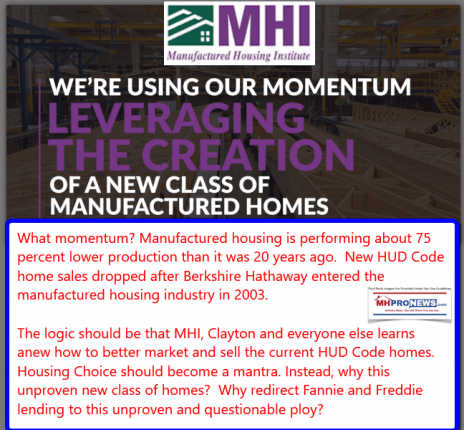
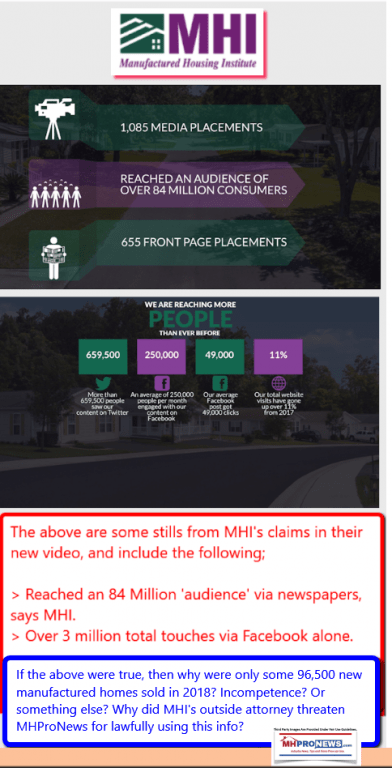
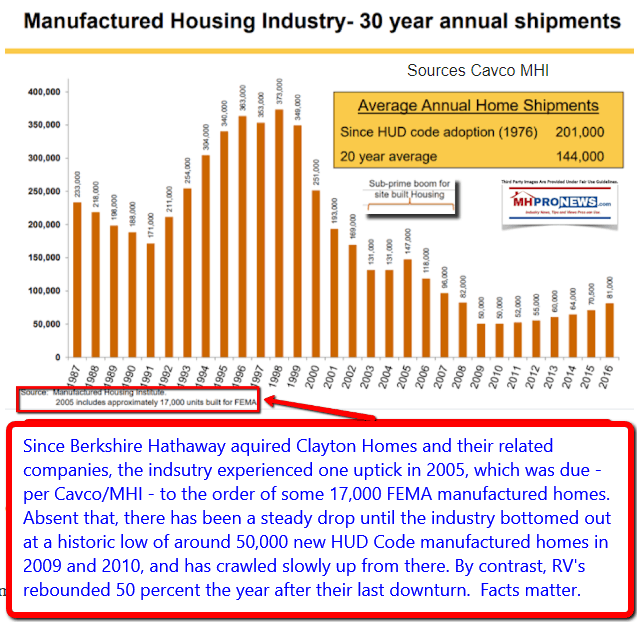
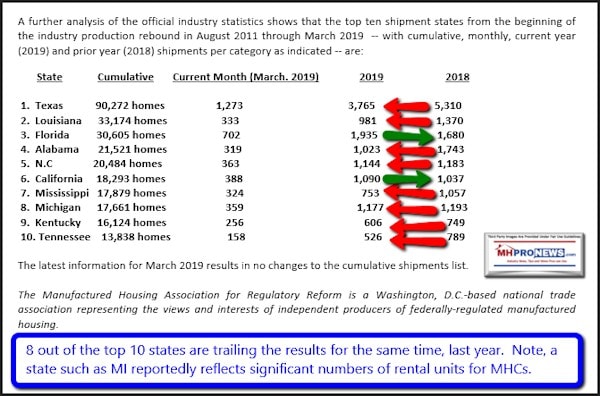
See the related reports, below the bylines, free email headline news signup, other offers, and notices.
Others are peddling spin, propaganda, deception, lies – whatever one may want to call it. Perhaps that’s why MHProNews traffic has roughly doubled in about a year?
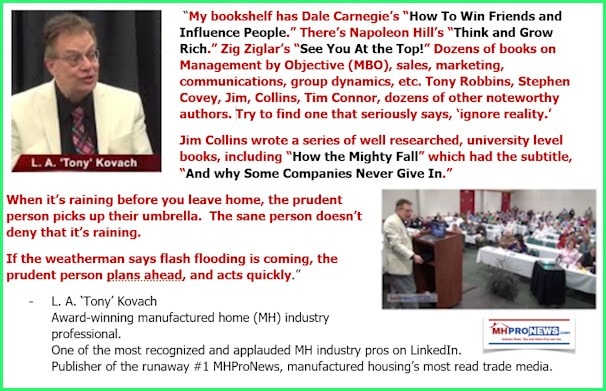
That’s this Monday evening edition from the #1 most-read “Industry News, Tips, and Views Pros Can Use,” © where “We Provide, You Decide.” © ## (News, analysis, and commentary.)

Your link to industry praise for our coverage, is found here.
For the examples of our kudos linked above…plus well over 1,000 positive, public comments, we say – “Thank You for your vote of confidence.”
“We Provide, You Decide.” © ## (News, analysis and commentary.)
(Image credits and information are as shown above, and when provided by third parties, are shared under fair use guidelines.)
Submitted by Soheyla Kovach to the Daily Business News for MHProNews.com.

2) To pro-vide a News Tips and/or Commentary, click the link to the left. Please note if comments are on-or-off the record, thank you.
3) Marketing, Web, Video, Consulting, Recruiting and Training Re-sources

Related Reports:
You can click on the image/text boxes to learn more about that topic.
Warren Buffett’s Profitable Lessons for Manufactured Housing
B2B Statistics, Trends 2019 – April 2019 Snapshot of Manufactured Home Professional Readers
MHARR Calls on HUD Secretary to End Discriminatory And Exclusionary Zoning of HUD-Regulated Manufactured Homes | Manufactured Housing Association Regulatory Reform
Washington, D.C., April 30, 2019 – The Manufactured Housing Association for Regulatory Reform (MHARR) in an April 24, 2019 communication to U.S. Department of Housing and Urban Development (HUD) Secretary, Ben Carson (copy attached), has called on the Department to federally preempt local zoning ordinances which discriminatorily exclude manufactured homes regulated by HUD pursuant to the National Manufactured Housing Construction and Safety Standards Act of 1974 and the Manufactured Housing Improvement Act of 2000.
“Lead, Follow … Or Get Out of The Way” | Manufactured Housing Association Regulatory Reform
The last decade-plus has not been especially kind to the manufactured housing industry and consumers of affordable housing. The 21 stCentury began with a great deal of promise for the industry and consumers alike.
HUD Code Manufactured Home Production Decline Persists – Time For Action Not Excuses | Manufactured Housing Association Regulatory Reform
Washington, D.C., February 4, 2019 – The Manufactured Housing Association for Regulatory Reform (MHARR) reports that according to official statistics compiled on behalf of the U.S. Department of Housing and Urban Development (HUD), HUD Code manufactured home production declined again in December 2018.

























